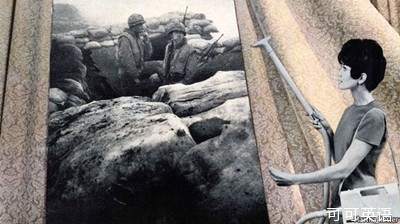Books and Arts; The Istanbul Biennial;Vintage is the new vanguard;

Virtually every day of the year sees another art biennial opening somewhere in the world. The role of these exhibitions is to showcase contemporary art, attract affluent tourists and stimulate local culture. Most biennials are a sprawling mess—and the worst look like commercial art fairs studded with brand-name trophies. However, those that succeed in making sense of some aspect of global culture can be both enlightening and memorable. This year's Istanbul Biennial, which opened on September 17th and runs for almost two months, is a case in point. Poignant, relevant and intellectually engaging, it has managed to create a coherent exhibition out of works by 130 artists from 41 countries—a rare achievement.
實(shí)際上,在一年中的每一天,在世界上的某個(gè)地方,都有一場(chǎng)藝術(shù)雙年展會(huì)舉辦。這些展覽的作用是展出當(dāng)代藝術(shù),吸引大量游客,并促進(jìn)當(dāng)?shù)匚幕l(fā)展。大多數(shù)雙年展不過是一團(tuán)糟——最糟糕的看起來就像商業(yè)性質(zhì)的藝術(shù)集會(huì),到處充斥著品牌的戰(zhàn)利品。不過,那些成功詮釋了全球文化中某個(gè)方面的雙年展倒是十分具有啟發(fā)性,值得紀(jì)念。今年,于9月17日開幕,為期將近兩個(gè)月的伊斯坦布爾藝術(shù)雙年展就是這樣一個(gè)雙年展。動(dòng)人,切題,十分具有知性吸引力,通過展出來自41個(gè)國(guó)家的130個(gè)藝術(shù)家的作品,它成功的創(chuàng)造出一場(chǎng)融會(huì)貫通的展覽——取得了罕見的成功。
The Istanbul Biennial is held in two huge former warehouses on the banks of the Bosporus. Untamed, the buildings would force viewers into a monotonous marathon of spectatorship. But the biennial's curators, Adriano Pedrosa (a Brazilian) and Jens Hoffmann (a Costa Rican), enlisted the help of a master of exhibition design, a Japanese architect called Ryue Nishizawa, who has introduced new energy into the space by creating rooms of different sizes and marking off “exterior” spaces with corrugated-steel walls.
伊斯坦布爾雙年展在博斯普魯斯海峽岸邊的兩座巨大的老舊庫(kù)房里舉行。如果不加修飾的話,這種建筑很容易讓觀眾陷入一種單調(diào)冗長(zhǎng)的觀賞過程之中。但是展館館長(zhǎng)阿德里亞諾佩德羅薩(巴西人)和吉斯霍夫曼(哥斯達(dá)黎加人)得到了一個(gè)展館設(shè)計(jì)大師的幫助,他是一位名叫西沢立衛(wèi)的日本建筑師,他建造了幾個(gè)大小不同的房間,并用波紋鋼板墻將外部空間區(qū)分開來,通過以上方式為整個(gè)空間注入了活力。
As curators, Mr Pedrosa and Mr Hoffmann have also adopted an effective premise. Rather than using a theory or theme as a unifying rubric, the biennial has a muse—Félix González-Torres, an artist who died in 1996 and who was selected posthumously to be the official American representative at the 2007 Venice Biennale.
做為館長(zhǎng),佩德羅薩和霍夫曼也采用了令人印象深刻的方式開幕。并沒有用千遍一律的紅字標(biāo)注展覽主題,這次的雙年展自己的繆斯——菲利克斯岡薩雷斯托雷斯,這位藝術(shù)家1996就英年早逝,死后在2007年的維納斯雙年展上被選為正式的美國(guó)代表。
Born in Cuba and educated in Puerto Rico, González-Torres made minimalist conceptual works that were aesthetically innovative and politically sophisticated. Like its muse, the Istanbul Biennial is thoughtful rather than aggressive or sensationalist. “Activists spoon-feed messages but artists create works with layered meanings,” explains Mr Pedrosa.
岡薩雷斯托雷斯出生于古巴,求學(xué)于波多黎各,他創(chuàng)造的抽象主義作品兼具美學(xué)的創(chuàng)新性和政治的復(fù)雜性。就像它的繆斯一樣,伊斯坦布爾雙年展的風(fēng)格是沉思的,而不是咄咄逼人或是多愁善感的。“政治活動(dòng)家向人們強(qiáng)制性的灌輸信息,然而藝術(shù)家創(chuàng)造意義層次分明的作品”,佩德羅薩如是解釋道。
The biennial also has an intelligent structure. There are five group shows around the main themes that inspired González-Torres's work—love, death, abstraction, contested histories and territories. Each group show occupies a large grey room and acts as a hub for a cluster of solo shows featuring 50 artists, all in smaller white rooms. The elegant solution to the spaces stands in contrast to the names of the group shows, which repeat “Untitled” in an awkward manner. Nevertheless, it is moving to walk through the room called “ ‘Untitled' (Ross)” named after the artist's longtime lover, Ross Laycock, who died in 1991 of Aids-related causes, like González-Torres himself.
雙年展的空間安排也十分討喜。有五組展出岡薩雷斯托雷斯的作品主題——愛,死亡,抽象,歷史紛爭(zhēng)以及領(lǐng)土紛爭(zhēng)。每一組展出都占據(jù)了一間灰色的大屋子,這些展出也是50個(gè)風(fēng)格各異的藝術(shù)家的獨(dú)展中心,所有的獨(dú)展在一間小一點(diǎn)的白屋子里進(jìn)行。和空間的完美分布形成對(duì)比的是展出的名字,這些展出都是清一色用一種尷尬的方式強(qiáng)調(diào)著“無題”這個(gè)名字。不過,你還是情不自禁的想去逛一逛這件名叫“無名(羅斯)”的房間,“無名(羅斯)”以岡薩雷斯托雷斯的最愛,羅斯雷科克命名,像岡薩雷斯一樣,他也于1991年死于艾滋病。
Another of the group shows, “ ‘Untitled' (Passport # II)”, displays 20 works about maps and national identity. Hank Willis Thomas's “A Place to Call Home” depicts North America and Africa as big black continents joined by an isthmus. Jorge Macchi's “Seascape” covers all the landmasses below the equator with cut-outs of the northern seas. Displayed as a commentary to Mr Macchi's drowned hemisphere is a video by Kutlug Ataman, one of Turkey's most critically acclaimed artists, which depicts bands of choppy sunlit water.
另一組展出名叫“無題(護(hù)照#II)”,展出了20幅關(guān)于地圖和國(guó)籍的作品。漢克威利斯托馬斯的作品“一個(gè)名叫家的地方”將北美洲和非洲刻畫成了兩個(gè)由地峽連接起來的黑色大洲。喬治馬奇的《海景畫》將北邊的海洋剪掉,描繪了赤道以南的所有陸地形態(tài)。卡特拉格奧特曼制作了一個(gè)視頻,算是對(duì)馬奇將整個(gè)半球浸在水里的做法的評(píng)論,卡特拉格是土耳其最后非議的一位藝術(shù)家,他在視頻里刻畫了一排排波光里里的海浪。
In a series of vitrines in the same room, Baha Boukhari, a Ramallah-based cartoonist, shows the passports issued to his father under the British mandate in Palestine. Many of the artworks incorporate objects and documents found in historical archives. Contemporary art in 2011 has a distinctly vintage feel.
在同一間房子里還擺放著一系列的玻璃櫥窗,拉馬拉籍卡托畫家巴哈布克汗展示了英國(guó)在巴勒斯坦發(fā)行給父親的護(hù)照。許多藝術(shù)作品都把就檔案里找到的物品和文件組合在一起。2011年的當(dāng)代藝術(shù)別有一番懷舊風(fēng)味。
The curators are right not to let themselves be overly distracted by the latest thing; work made yesterday is not always the art that is most relevant to the present. They have chosen to include a range of historical artworks by women who they believe deserve greater recognition. For example, they have installed photo collages from Martha Rosler's “Bringing the War Home” series (pictured above), which were made during the Vietnam war between 1967 and 1972, but which still resonate because of America's continuing presence in Iraq and Afghanistan.
這兩個(gè)館長(zhǎng)十分明智,沒有過分受到潮流的影響;但是過去創(chuàng)造的作品并不總是和現(xiàn)在密切相關(guān)。于是他們選擇了一系列由女藝術(shù)家創(chuàng)作的老作品,因?yàn)樗麄冋J(rèn)為女性藝術(shù)家更應(yīng)該受到公眾認(rèn)同。比如他們安插了一系列由瑪莎羅絲拍攝的名為“把戰(zhàn)爭(zhēng)帶回家”照片(見上圖),這些照片攝于1967年到1972年越戰(zhàn)時(shí)期,因?yàn)槊绹?guó)發(fā)動(dòng)了伊拉克戰(zhàn)爭(zhēng)和阿富汗戰(zhàn)爭(zhēng),所以它們?cè)诮裉烊匀荒芤饛V泛共鳴
The Istanbul Biennial also gives solo shows to a number of exciting emerging artists. Many visitors were impressed with “Cabaret Crusades: The Horror Show File”, a video by Wael Shawky, an Egyptian artist, in which marionettes act out the story of the crusades from an Arab point of view. Also much discussed were “Tin Soldiers” by Ala Younis, a Jordanian, and “Historical Record Archive” by Dani Gal, an Israeli artist.
伊斯坦布爾雙年展還給許多令人振奮的藝術(shù)新星舉辦了獨(dú)展。由希臘藝術(shù)家威爾夏科拍攝的視頻——“卡巴來改革:恐怖展覽檔案”給許多參觀者留下了深刻的印象,在這段視頻里,他從阿拉伯視角,用各種木偶演繹了改革的故事。約旦藝術(shù)家阿拉又斯的“小錫兵”和以色列藝術(shù)家丹尼蓋爾的“歷史檔案記錄”也掀起了一場(chǎng)熱議。
It is interesting to view these works against the background of the recent political upheavals in the Middle East and to see the unexpected interaction between Arab artists and those from South America. Both areas are on the periphery of European modernity and the biennial's artists have found much common ground over urban decay, disenfranchisement and the arbitrariness of national borders. Mr Pedrosa and Mr Hoffmann have played to their strengths, choosing more artists from South America than any other continent. It is a testament to the Turkish philanthropists who underwrite the biennial, particularly the Koc and Eczacibasi families, that the curators came under no pressure to include more local artists. Indeed, the stylish internationalism of the Istanbul Biennial feels entirely natural.
在近期中東政治動(dòng)蕩的大背景下審視這些作品是件很有意思的事情,還能乎意料的看到來自阿拉伯和南美的藝術(shù)家之間的互動(dòng)。這兩個(gè)地方都深受歐洲現(xiàn)代性影響,來參加雙年展的藝術(shù)家們?cè)诔鞘袎櫬洌駲?quán)喪失以及國(guó)界犯罪猖獗等方面找到了共同話題。佩德羅薩和霍夫曼憑借一定便利請(qǐng)到了許多南美藝術(shù)家,要多于來自其他大洲的藝術(shù)家。這次雙年展也見證了贊助方土耳其的慈善精神,尤其是科克和伊扎斯巴斯兩大家族,兩位館長(zhǎng)以及許多當(dāng)?shù)氐乃囆g(shù)家都來自這兩大家族。毋庸置疑的是,伊斯坦布爾雙年展的國(guó)際風(fēng)格毫不做作,給人感覺十分自然。











